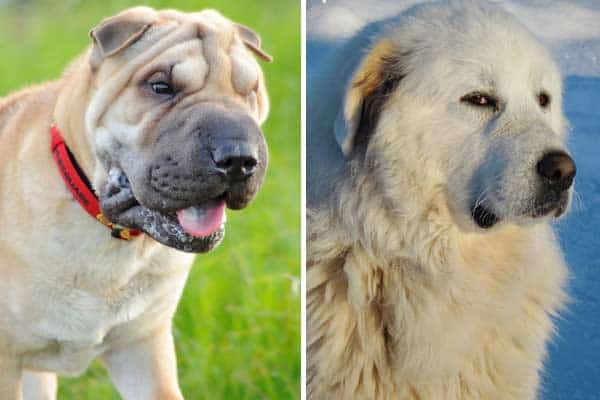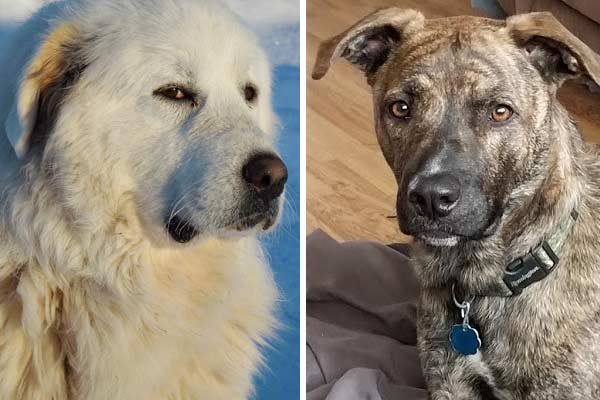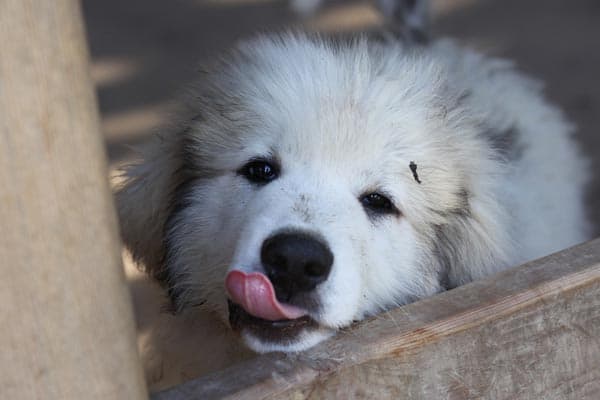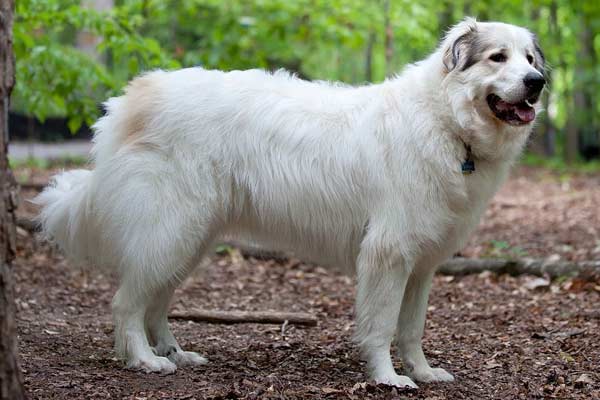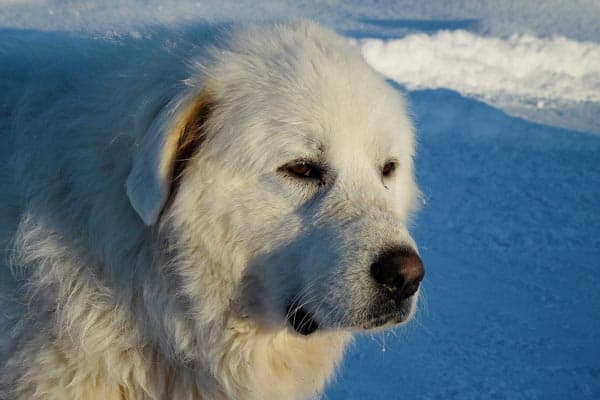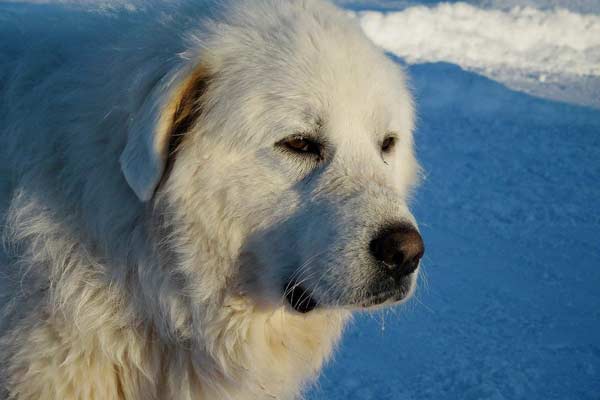Great Pyrenees: the Huge Dog With a Huge Heart
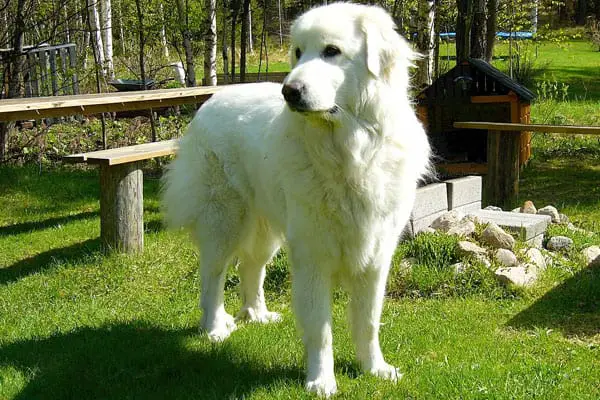
The Great Pyrenees is 100 percent pure dog. Not only are these enormous dogs loyal and loving to a fault, but they are every bit as thick and shaggy as a proper dog should be.
The Great Pyrenees is a gentle giant, but there are some special considerations when you are committing to care for one of these oversized pups.
In this article, learn everything you need about the Great Pyrenees dog. The information in this article will help you whether you are already caring for the Great Pyrenees or are considering adding this majestic dog to your family.
Great Pyrenees
The Great Pyrenees is a giant working dog breed with a long history of guarding and protecting livestock.
Great Pyrenees have a strong guarding and protective instinct and a strong need to herd “their” flock, be that you, your kids, or even the family cat.
These dogs are often described as majestic, calm, and easygoing – at least until they detect a threat. They are loyal and loving towards their humans.
Watch a Great Pyrenees in Action
This awesome YouTube video gives you a short and sweet overview of the Great Pyrenees as a dog breed, a protective K-9, a companion canine, and a family-friendly pet.
As the video points out, like many internationally popular dog breeds, the Great Pyrenees has several names depending on what country you live in. For example, the breed name in Europe is the Pyrenean Mountain Dog.
The video also points out two breed lines: show and working.
Your reason for choosing a Great Pyrenees should dictate which type of breeder you choose to work with to find your puppy. Rescuing an adult Great Pyrenees is also a great option to give a great dog a new forever home.
History of the Great Pyrenees
According to the Great Pyrenees Club of America, the Great Pyrenees dog’s modern history stretches back to at least the 14th century, thanks to writings that describe these dogs.
But historians suspect their history stretches back much further – back to 3,000 B.C.! It is possible they originated with the Basque people, who are known to be direct descendants of the Cro-Magnon people.
As the Indy Great Pyrenees Rescue charity explains, the Great Pyrenees has always worked as herding, guarding, and protecting dogs for both people and livestock animals.
In this work, Great Pyrenees dogs often confronted fearsome predators such as wolves, bears, or human poachers. These dogs became famous for refusing to back down no matter what the threat happened to be.
The isolation of the Pyrenees mountains contributed to the preservation of certain unique breed traits that the Great Pyrenees still exhibits today, as we will discuss in the rest of this article.
Great Pyrenees Size, Height, and Weight
The Great Pyrenees fully lives up to the “great” in their breed name. These dogs are big!
While the American Kennel Club (AKC) official breed description states that they weigh 85 to 100 pounds and up, plenty of data online suggests 160 pounds is not out of the question.
Adult females tend to weigh about 15 pounds less than adult males, not that that matters much when you get into the triple digits.
In terms of height, an adult female might stand 25 to 29 inches tall (paw pads to withers), and an adult male typically stands 27 to 32 inches tall.
These dogs will finish growing up before they finish growing out. Like many large to giant breed dogs, they can take an extra year or two to “fill out” to their full adult weight.
Great Pyrenees Personality and Temperament
What is the Great Pyrenees dog-like in terms of their temperament and personality?
Gets along well with kids and cats
These dogs are known to get along well with children and cats, which isn’t the case for many dog breeds!
These dogs have strong guarding and protective instincts, making them territorial of their home and property and aloof with people they don’t know.
Known to herd their people
Their long history of guarding, protecting, and herding can also mean they try to keep everyone together, leaning, nipping, or barking to indicate how they want their “herd” to move.
For this reason, the Great Pyrenees may not be the safest choice if you have very small children, only because an accidental injury could occur if a large dog leans against a small child. Otherwise, they are known to be quite gentle with children.
Need help managing their territorial instincts
Great Pyrenees dogs are meant to be companion canines, and family pets need a lot of early and ongoing socialization and training starting on day one.
They need to learn how to manage their territorial instincts to tell the difference between a real threat and a friendly visitor.
Can be independent and even stubborn
Great Pyrenees have spent so many centuries working at an independent job that they can also be independent and stubborn.
These dogs will keep their own counsel about what is a threat and what isn’t, which works well when there is a herd of cattle and a hungry wolf. But it may not work well when trying to keep your dog from counter-surfing the steak.
Calm, patient persistence with training will help you make daily progress. Keep training sessions short and interesting, or your intelligent dog will quickly lose interest.
Rather than doing one long training session a day, try breaking the sessions into short chunks and adding lots of positive reinforcement to keep them fun.
Need to learn early on what not to do for safety reasons
Because Great Pyrenees are very strong, powerful, large dogs, you don’t want to encourage your puppy to lean on you, head butt you, or sit in your lap.
This is super cute in puppyhood but can be unmanageable when your dog grows big. It can also end up causing injury to children or elderly loved ones, even when your dog doesn’t mean to.
Great Pyrenees Socialization and Training Needs
Speaking of socialization and training, let’s talk about what kind of socialization and training your Great Pyrenees puppy or rescue dog will most benefit.
The Great Pyrenees must learn specific skills to adapt to life in pet sitting. This is especially true if you have kids who like having friends over to play. Never leave your Great Pyrenees unsupervised in these situations.
You can expect your independent Great Pyrenees to be somewhat stubborn about learning commands like “sit,” “stay,” and “heel.”
This isn’t because your dog wants to disobey you. These commands would not be useful to the work this dog is bred to do. Persist, using positive reinforcement like praise, pats, treats, and play to encourage your dog to obey.
According to the Great Pyrenees Club of America, a Great Pyrenees puppy should not be enrolled in any formal guarding or protection K-9 training until they are six months old.
But once your dog is six months old or older, a training course in guarding and protecting dog skills will benefit you and your dog. You don’t want your dog to accidentally cause injury because their protective instincts hurt an innocent visitor.
Great Pyrenees Exercise and Activity Level
The Great Pyrenees breed has traditionally patrolled large herds of livestock over difficult terrain in some very challenging weather conditions.
This often leads people to think the Great Pyrenees is a very high-energy dog that needs lots of intense physical exercise daily. While the Great Pyrenees love running and playing, they can also be surprisingly chill!
However, because of the Great Pyrenees’ large size, you want to avoid high-impact K-9 sports too early in life. These could cause damage to the joints, bones, and tissues while your dog is still growing.
To make sure your dog is done growing, your veterinarian takes X-rays of the leg bones. When the growth plates have closed and hardened, your veterinarian can see this on the X-rays and confirm that your dog can exercise more vigorously.
Good K-9 sports for a large dog like the Great Pyrenees can include cart-pulling, herding, tracking, agility, search and rescue, and obedience.
Great Pyrenees dogs also make amazing service and therapy dogs, where their naturally calm temperament and natural love of people become a real asset. A mature, fully grown Great Pyrenees can enjoy hiking treks and long walks with their people.
Great Pyrenees Coat Care and Grooming
The Great Pyrenees dog’s thick, shaggy coat often earns these dogs a second look. That is a whole lot of dog hair to groom and manage!
But there is an essential safety reason behind why these dogs have thick coats.
The Great Pyrenees takes their breed name from the Pyrenean Mountains that separate France and Spain. These mountain ranges get cold in the winter, which explains the Great Pyrenees’s thick, long, shaggy coat.
The outer layer of the Great Pyrenees dog’s coat is thicker, coarse, and water-resistant. It protects the dog from sunburn, windburn, wetness, cold, pests, and injury.
The Great Pyrenees coat’s inner layer is soft, insulating, and warm. This layer functions like the dog’s winter coat. It will shed out when the season shifts to warm weather; an event dog owners call the “coat blow.”
It is called the coat blow because huge sections of the undercoat will be shed out at once in a literal “snow burst” of dog hair.
In addition, the outer layer of the coat sheds lightly year-round. But with such a large dog, even light shedding can seem like a lot of shedding.
One thing you never want to do is shave your Great Pyrenees. This will destroy all the protection the coat provides. The two layers will no longer grow in separate layers with distinct properties. Instead, the two layers will mingle.
This cannot be undone. The dog needs their thick fur for cooling as much as for warmth. This may mean you need to keep your Great Pyrenees inside when the temperatures get too warm, and there is a risk of overheating during the summer.
Great Pyrenees Health and Life Expectancy
The Canine Health Information Center, or CHIC for short, keeps an updated list of known genetic (heritable) health issues that can affect many purebred dog breeds.
Why is it important to know about these genetic health concerns?
Because reputable breeders that care about their reputation in dog breeding and the health of the breed itself will ensure not to breed dogs that test positive for these conditions.
For the Great Pyrenees dog, the health conditions that parent dogs should be pre-tested and cleared for include these:
- Hip dysplasia.
- Patellar luxation.
- Eye issues.
- Cardiac issues.
- Thyroid issues.
- Elbow and shoulder issues.
Overall, the Great Pyrenees has an average life expectancy of between 10 and 12 years. This is not unusual for giant breed dogs, which sadly seem to have life expectancies inversely proportion to their size.
Is the Great Pyrenees the Right Next Dog for You?
Is the Great Pyrenees the right dog breed for you and your family? For the right owners, there is no more loyal, loving, protective, intelligent, and caring dog in the world.
